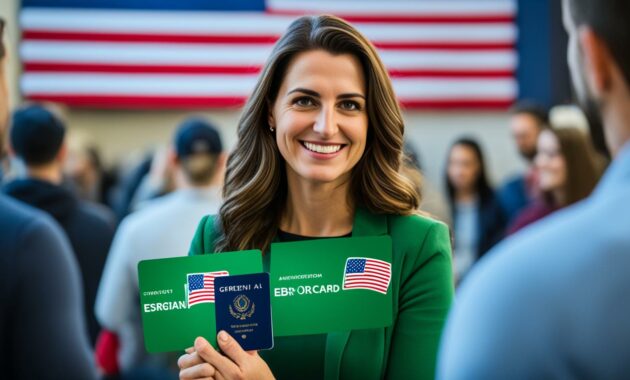The EB-1C green card is a hidden gem in U.S. immigration. It’s not as well-known but is a great way to get permanent residency quicker and more easily than many other employment-based green cards1.
The EB-1C visa is designed for some top-level managers and executives. It offers a much faster process compared to several other types of visas1. The application can be completed in little over 7 months. If you pay extra, you can get your decision in just 15 days by opting for premium processing1.
Even though the EB-1A category is quicker and doesn’t require a job offer, the EB-1C is still a good choice. It’s especially useful for managers or executives working for a U.S. arm of a foreign company1.
Healthcare in the U.S. is very expensive. But, the EB-1C offers a cheaper way to get a green card. This is a big benefit, especially when you think about how much it costs to treat serious injuries or stays in the hospital1.
Another advantage of getting the EB-1 green card is it makes you eligible for U.S. citizenship. This can happen after you have lived as a permanent resident for five years1.
Also Read EB-1C Green Card: The (Relatively) Affordable Fast Track You Didn’t Know About
What is an EB-1C Green Card?
The EB-1C green card helps multinational executives and managers work in the U.S. It is part of the EB-1 visa group, known for its quick approval2.
The EB-1C Subcategory of the EB-1 Priority Worker Category
It’s for executives or managers who’ve worked outside the U.S. for one of the past three years. They should be moving into a similar role with a U.S. arm of the same company. This includes branches, affiliates, or subsidiaries. The U.S. part of the company should be at least a year old23.
Eligibility Criteria for Multinational Executives and Managers
To get the EB-1C, you need to be working in a top position abroad. This could mean overseeing staff, or handling vital parts of the business. You might coordinate the company’s main goals, or make big decisions3.
Your U.S. employer must prove a real link between their foreign and U.S. operations. They should also show they can pay your salary3.
What’s great about this visa is you don’t need the usual Labor Certification process. This means you can get your green card quicker. But, you must still have a job offer from a U.S. employer, unless you can self-petition with outstanding performance in your field3.
“The waiting periods for an EB-1C visa are typically short or non-existent, with examples such as a one-year waiting period mentioned2. As of August 2022, there are currently no waiting periods for the EB-1C visa2.”
Applying for the EB-1C green card costs USD 220. It’s open to the unmarried, under 21 children, and spouses of applicants. Once you have your green card, you’re not tied to one employer, unlike with some work visas234.
EB-1C Visa Cost: Immigration Fees and Legal Expenses
Getting an EB-1C green card comes with costs. This includes both immigration fees and the costs of hiring a lawyer. The filing fee for the I-140 Form is $7005. Opting for faster processing with the premium service adds another $2,5005.
Legal help with your EB-1C application might cost between $5,000 to $15,000. This depends on your case’s complexity and your attorney’s experience5. Some law firms might have a set price for EB-1C applications5.
Spouses and unmarried kids under 21 also have fees. For each person, the I-485 Form costs $1,225. There’s also a $230 fee, a $85 biometric fee, and an $88 Affidavit of Support fee. Depending on the visa, each person’s fees will total between $750 to $1,1405.
Keep in mind, the EB-1C visa doesn’t have a premium processing option. So, it usually takes 7.5 to 16 months for the I-140 to be processed5.
When comparing it to the EB-5 visa, the EB-1C is seen as less costly. The EB-5 might require $800,000 and legal fees of $60,000 to $70,000. However, the EB-1C offers more flexibility in investment amount and a quicker visa processing time6.
“The EB-1C program provides a direct pathway to permanent residency with control over funds and assurance of a long-term path to citizenship.”6
Before getting the EB-1C visa, it’s vital to plan your budget. Take into account all the fees involved and the time it will take for your application to process. Knowing how the EB-1C stacks up against other visas is also important.
Comparing EB-1C to Other Employment-Based Green Cards
The EB-1C visa, known for multinational executives and managers, has big advantages over other green cards7. It’s faster to get, usually just 4 to 6 months7. Many other green cards can take years. This makes the EB-1C a great choice for those wanting to move to the U.S. quickly.
The EB-1C doesn’t need a labor certification, which is a must for most green cards8. This speeds up the process and cuts out the need for an employer to do a hard labor market test8. Also, you don’t need a job offer or support from an employer like with the EB-1B for top professors and researchers9.
This visa lets skilled execs and managers help the U.S. economy and make new jobs7. Even U.S. Presidents see its role in growing the economy7. It’s top choice for big companies moving their important staff to the U.S7..
Advantages of the EB-1C over Other Visa Categories
- Shorter processing time, often just 4-6 months, compared to years for other employment-based green cards7
- No labor certification requirement, streamlining the application process8
- No job offer or employer sponsorship needed, unlike the EB-1B visa for outstanding professors and researchers9
- Recognized for its economic benefits, with U.S. Presidents highlighting its importance in promoting growth7
- Particularly popular among multinational companies for transferring key executives and managers7
Summing up, the EB-1C visa is quicker and more open than other green cards. This makes it a great choice for sharp international business leaders and managers798.
Employer Sponsorship Requirements for EB-1C
The EB-1C visa, or the Multinational Manager or Executive Green Card, is not like the EB-1A or EB-1B. The big difference is that it needs employer support10. The U.S. company must be linked to the foreign employer in some way. It should be a branch, affiliate, or subsidiary. Also, it must have been running for at least a year10.
The company supporting the application must file the I-140 Petition for Alien Worker. They must also prove they can pay the expected salary11. This step can take 6-11 months because the EB-1C visa doesn’t have a faster option like the EB-1A and EB-1B10.
- The U.S. company must be a branch, affiliate, or subsidiary of the foreign employer and be at least a year old10.
- The supporting employer needs to submit the I-140 Petition for Alien Worker and show they can afford the salary11.
- EB-1C visa applications take 6-11 months because there’s no Premium Processing for this category10.
The EB-1C visa is easier to get than the EB-1A and EB-1B for certain people. This includes multinational company executives and managers. It’s because the qualifications are less strict12.
Knowing the rules for employer support with the EB-1C visa can help a lot. It gives foreign workers at multinational companies a better shot at getting a U.S. green card111012.
“The EB-1C visa gives executives and managers at multinational firms a quicker way to get a green card. This is unlike other work-based green card options.”
The EB-1C Visa Application Process
The first step in getting the EB-1C visa is your employer filing the I-140 Petition for Alien Worker with USCIS for you13. You won’t pay the $715 filing fee; your employer does13. After filing, USCIS takes over 4 months to decide unless you pay an extra $2,500 for faster processing13.
If your I-140 petition gets a thumbs up, you can then file the I-485 Application. This step is for getting your green card13. Filing this form costs $1,44013. You’ll also need to pay other fees like the $235 Immigrant Fee, $345 DS-260 Filing Fee, and the $120 I-864 Filing Fee13.
Step-by-Step Guide to Applying for the EB-1C Visa
- Employer files the I-140 Petition for Alien Worker with USCIS on the applicant’s behalf.
- USCIS reviews the I-140 petition, which generally takes over 4 months to receive a decision.
- Applicant can request premium processing for $2,500 to expedite the I-140 process to 15 days.
- If the I-140 is approved, the applicant can file the I-485 Application to Register Permanent Residence or Adjust Status.
- Applicant must pay additional fees, including the $235 Immigrant Fee, $345 DS-260 Filing Fee, and $120 I-864 Filing Fee.
To apply for the EB-1C visa, show you’re well-known and valued in your area of work. You also need a job offer from a U.S. employer14. This visa type doesn’t have a set number of spots available. Plus, if you have a spouse or kids under 21, they can also get a visa14.
| EB-1C Visa Application Fees | Cost |
|---|---|
| Form I-140 Filing Fee | $71513 |
| Immigrant Fee | $23513 |
| Form I-485 Filing Fee | $1,44013 |
| Form DS-260 Filing Fee | $34513 |
| Form I-864 Filing Fee | $12013 |
| Premium Processing Fee (Form I-907) | Variable, consult USCIS Fee Calculator15 |
| Legal Fees | $6,800 ($5,600 at the start, $1,200 at I-485 preparation)15 |
| Federal Express Expenses | Approximately $20015 |
| Additional Paperwork Preparation Fee | $25015 |
The EB-1C visa is not simple to get, so it’s smart to work with an immigration lawyer. Boundless Immigration, USCIS, and Immigration.com have helpful info for the EB-1C process.

“The EB-1C visa is a strong choice for top managers and executives worldwide to gain U.S. permanent residency. With a straightforward process and no max limit on visas, it offers great opportunities for qualified professionals.”
EB-1C Eligibility Criteria: Qualifications and Requirements
The EB-1C visa offers a fast and less expensive way to get a green card in the U.S. To get this visa, applicants need to meet certain criteria16.
The applicant must have worked outside the U.S. for the same company, or its branch, for a year in the last three years16. The applicant also needs to show they’ll continue this job in a managerial or executive role16.
The job link between the foreign and U.S. companies can be as a parent, subsidiary, branch, or affiliate16. This connection is checked by looking at ownership, control, and business activities16.
For executive or managerial roles, the EB-1C visa recognizes two types: managers of people and managers of functions16. The applicant must prove they manage a team or oversee an important area in the organization16.
The visa’s demands for executives focus on four main duties: to set the company’s goals, to make important decisions, to work with little supervision, and to manage the company or a part of it16.
It’s key that the applicant worked for the foreign company for a year within the last three years16. Also, the U.S. business must have operated for a year before the visa petition16.
The EB-1C visa is very popular, with most EB-1 visas going to this category17. The whole process can be finished in 6 months but waiting for a visa number can take longer, up to 5 years, depending on many factors17.
In contrast, the EB-1A and the EB-1B have tighter rules, including needing to show high achievement or have teaching or research experience. These categories can be sped up in 15 days with premium processing, an option not available for EB-1C applicants17.
For EB-1B and EB-1C, the U.S. business must operate for a year and be related to the foreign company where the applicant worked. The timing of when the visa number is available is crucial, and the wait time can change a lot17.
Though the EB-1C process is quicker and easier than other EB-1 visas, it still needs applicants to show their high-level job skills. They must also prove they have a job offer and qualify based on working outside the U.S. for some time17.
Surprisingly, the EB-1C visa has been granted to not just big companies but also to smaller ones and startups18. Filing an EB-1C petition without speeding it up takes around 6 months. Yet, you can pay to have it done faster, in just 45 days, starting January 30, 2023, for $2,80518.
In brief, the EB-1C visa provides a way for qualified managers and executives to quickly get a green card in the U.S. By knowing what is needed and how to apply, these candidates can make the most of this immigration opportunity161718.
Permanent Residency and Citizenship Pathways
Getting an EB-1C green card is a big achievement. It marks the start of gaining a green card and then U.S. citizenship. After getting the EB-1C status, the next goal is to get a green card. This allows them to stay in the U.S. for good19.
To do this, they must file the I-485 form with USCIS. If this is accepted, they get a green card. This lets them live and work anywhere in the U.S. they want19.
Transitioning from EB-1C to Lawful Permanent Resident Status
With the EB-1C green card, they can aim for U.S. citizenship. They need to live as a permanent resident for five years. Then, they can apply for citizenship by filing the N-400 form. This also means they must show they’re a good person, and pass English and civics tests20.
Compared to the L-1A visa, the EB-1C gives a clearer way to a green card. With an L-1A visa, you need to go through another process to get a green card20. When you have an EB-1C application, it’s important to keep track of the priority date. This date affects when you can move forward with your application20.
| Visa Category | Pathway to Permanent Residency | Citizenship Eligibility |
|---|---|---|
| EB-1C | Direct pathway to green card | 5 years of continuous residence as a permanent resident |
| L-1A | Separate green card application process | 5 years of continuous residence as a permanent resident |

The EB-1C green card opens a clear and cost-effective way to stay in the U.S. But, it’s important to know all the steps and requirements. This helps eligible people make the best of the chance to call the U.S. their permanent home192021.
Healthcare Coverage for EB-1C Green Card Holders
Being an EB-1C green card holder makes quality healthcare a huge priority. In the U.S., medical costs are high. For example, fixing a broken leg or arm may cost over $17,000. Also, staying in the hospital can be more than $2,000 a day22. It’s important to choose an affordable health insurance plan. This helps you avoid big bills for medical care you might need.
EB-1C green card holders can get health insurance in the U.S. This offers financial safety and the needed medical care. It’s key to look at things like monthly costs, deductibles, and what services are covered. This way you can pick a plan that’s just right for you.
Having good health insurance helps EB-1C green card holders a lot. It cuts down on the expensive costs of medical care in the U.S. Without it, medical bills can grow fast and shake your financial security. Choosing the right plan lets you focus on work and life, knowing you’re protected.
| Health Insurance Plan Feature | Explanation |
|---|---|
| Monthly Premium | The recurring fee paid to maintain health insurance coverage. |
| Deductible | The amount you must pay out-of-pocket before the insurance plan starts covering costs. |
| Co-payment | The fixed amount you pay for a covered healthcare service, such as a doctor’s visit or prescription. |
| Scope of Coverage | The range of medical services, treatments, and procedures included in the insurance plan. |
Thinking about these details helps EB-1C green card holders pick the right health insurance. They can choose a plan that keeps them healthy and protects their finances in the U.S2324.
“Securing comprehensive health insurance is a crucial step for EB-1C green card holders to safeguard their financial and medical well-being in the United States.”
Conclusion: Is the EB-1C Right for You?
The EB-1C green card is a quick and cost-effective way to get a green card in the USA25. It suits people who have high positions at companies outside the USA but want to work here now25. But, make sure you fit all the requirements before you apply for this visa.
To get an EB-1C, you don’t need to prove there are no Americans for the job, which saves time and money26. Also, getting an EB-1C means you become a permanent resident right away. This is different from EB-5 visas, where you wait for your green card to become permanent26. Plus, the process is usually faster because there’s no waiting line for visas like in some other cases26.
But, the EB-1C has some key needs. You must have worked in a high position for the same company in the USA for at least a year. And, the U.S. company must be linked to the one you worked for out of the country27. Also, the application isn’t as fast as some might want. It can take 6-8 months, or even longer if they ask for more evidence27. It’s a good idea to talk to a lawyer who knows about immigration to check if you can apply and to help you through the process.

